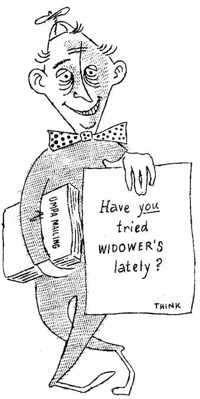Widowers
Widowers is a fictional Manchester, UK, department store created by Eric Needham, for which rhyming advertising jingles became a fannish fad after the first of them appeared in the second ish of Needham and Harry Turner’s OMPAzine, Now & Then (November 1954). An example by Needham:
Judas hung himself from a bough
A curious use for trees...
What use to perish, no more to cherish
WIDOWERS WONDERFUL PEAS?
The best of these four-line verses have a completely absurd counterpoint between the first couplet and the product promoted in the last; a rhyme scheme of abccb, with an internal rhyme in the third line; and, ideally, do not rely on a preposition to begin the final line.
In the 1980s, Harry Turner recalled:
WIDOWER'S WONDERFUL PRODUCTS appeared in the mag early on. Eric Needham, my co-producer, did some bulk-buying to economise on his house-keeping, and confessed he was getting fed up with a steady diet of Batchelor's Baked Beans. After a discussion on the techniques of persuasion, Eric tried his hand at some advertising jingles for the products from an imaginary company — Widower's. I used the results as fillers in N&T, and we found readers joining in with new jingles. There was a time when we had so many jingles on our hands that we had plans to produce a WIDOWER'S CATALOGUE...
And in the third issue of N&T, Eric came up with the strange story of WIDOWER'S WART REMOVER.
The Widowers trend has periodically seen a revival, notably in the 1970s and ’80s, and in 2000, after Leah Zeldes Smith wrote a number of them as fillers for STET 9, including:
Socrates, so wise, drank hemlock
And that was the end of him
So much for high thinking, you’re
better off drinking
WIDOWERS LONDON DRY GIN
More reading:
See also Daffy Poetics, Poetry, Rich Lynch.
| Fanspeak | 1954— |
| This is a fanspeak page. Please extend it by adding information about when and by whom it was coined, whether it’s still in use, etc. |
